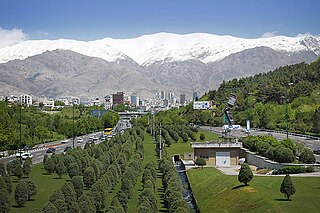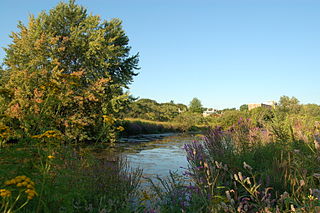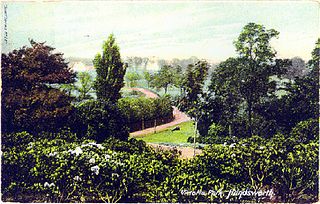
Oskarshamn Municipality is a municipality in Kalmar County in south-eastern Sweden, where the city Oskarshamn is seat.

A green belt is a policy, and land-use zone designation used in land-use planning to retain areas of largely undeveloped, wild, or agricultural land surrounding or neighboring urban areas. Similar concepts are greenways or green wedges, which have a linear character and may run through an urban area instead of around it. In essence, a green belt is an invisible line designating a border around a certain area, preventing development of the area and allowing wildlife to return and be established.

Hyde Park, Sydney, is an urban park, of 16.2-hectare (40-acre), located in the central business district of Sydney, in the City of Sydney local government area of New South Wales, Australia. It is the oldest public parkland in Australia. Hyde Park is on the eastern fringe of the Sydney city centre and is approximately rectangular in shape, being squared at the southern end and rounded at the northern end. It is bordered on the west by Elizabeth Street, on the east by College Street, on the north by St James Road and Prince Albert Road and on the south by Liverpool Street.

Queen's Park is an urban park in Downtown Toronto, Ontario, Canada. Opened in 1860 by Edward, Prince of Wales, it was named in honour of Queen Victoria. The park is the site of the Ontario Legislative Building, which houses the Legislative Assembly of Ontario. The phrase "Queen's Park" is regularly used as a metonym for the Government of Ontario or the Legislative Assembly of Ontario.

Lund is a city in the southern Swedish province of Scania, across the Öresund strait from Copenhagen, Denmark. The town had 91,940 inhabitants out of a municipal total of 121,510 as of 2018. It is the seat of Lund Municipality, Scania County. The Öresund Region, which includes Lund, is home to more than 4.1 million people.

Kalmar is a city in the southeast of Sweden, situated by the Baltic Sea. It had 41.388 inhabitants in 2020 and is the seat of Kalmar Municipality. It is also the capital of Kalmar County, which comprises 12 municipalities with a total of 236,399 inhabitants (2015). Kalmar is the third largest urban area in the province and cultural region of Småland.

Oskarshamn is a coastal city and the seat of Oskarshamn Municipality, Kalmar County, Sweden with 17,258 inhabitants in 2010.

Alewife Brook Reservation is a Massachusetts state park and urban wild located in Cambridge, Arlington, and Somerville. The park is managed by the state Department of Conservation and Recreation and was established in 1900. It is named for Alewife Brook, which was also historically known as Menotomy River, a tributary of the Mystic River.

Handsworth Park is a park in the Handsworth area of Birmingham, England. It lies 15 minutes by bus from the centre of Birmingham and comprises 63 acres of landscaped grass slopes, including a large boating lake and a smaller pond fed by the Farcroft and Grove Brooks, flower beds, mature trees and shrubs with a diversity of wildlife, adjoining St. Mary's Church, Handsworth to the north, containing the graves of the fathers of the Industrial Revolution, James Watt, Matthew Boulton and William Murdoch, and the founders of Aston Villa Football Club and the Victoria Jubilee Allotments site to the south opened on 12 June 2010. The completion of a £9.5 million restoration and rejuvenation of Handsworth Park was celebrated with a Grand Re-Opening Celebration led by Councillor Mike Sharpe, the Lord Mayor of Birmingham, speaking from the restored bandstand at 2.00pm on Saturday 8 July 2006, followed by a count down by a large enthusiastic crowd and the release of clouds of confetti; in the words of one observer "Great wedding! Now we must make the marriage a success."

Lafayette Square is a neighborhood in St. Louis, Missouri, which is bounded on the north by Chouteau Avenue, on the south by Interstate 44, on the east by Truman Parkway, and on the west by South Jefferson Avenue. It surrounds Lafayette Park, which is the city's oldest public park — created by local ordinance in 1836.

Scanian law is the oldest Danish provincial law and one of the first Nordic provincial laws to be written down. It was used in the geographic region of Danish Skåneland, which at the time included Scania, Halland, Blekinge and the island of Bornholm. It was also used for a short period on the island of Zealand. According to some scholars, the Scanian Law was first set down between 1202 and 1216, around the same time it was translated into Latin by the Danish Archbishop Anders Sunesøn.

Beckomberga Hospital was a Swedish psychiatric hospital, situated in Bromma west of Stockholm. Opened in 1932, Beckomberga was one of the largest psychiatric hospitals in Europe, at its peak housing some 2,000 mentally ill patients. The hospital closed in 1995.

Durand Eastman Park is a 977-acre (3.95 km2) park located partly in Rochester, and partly in Irondequoit, New York. It is administered by the Monroe County Parks Department under agreements with the City of Rochester and the Town of Irondequoit.

The Parc de la Tête d'or is a large urban park in Lyon, France, with an area of approximately 117 hectares. Located in the northern part of the 6th arrondissement, it features the Jardin botanique de Lyon, as well as a lake on which boating takes place during the summer months. Due to the relatively small number of other parks in Lyon, it receives a huge number of visitors over summer; it is a frequent destination for joggers and cyclists.

Munkkiniemi is a neighbourhood in Helsinki. Subdivisions within the district are Vanha Munkkiniemi, Kuusisaari, Lehtisaari, Munkkivuori, Niemenmäki and Talinranta.

Småland is a historical province in southern Sweden. Småland borders Blekinge, Scania, Halland, Västergötland, Östergötland and the island Öland in the Baltic Sea. The name Småland literally means Small Lands. The Latinized form Smolandia has been used in other languages. The highest point in Småland is Tomtabacken, at 377 metres (1,237 ft). In terms of total area, Småland is similar in size to Belgium and Israel.

Oskarshamn Shipyard is a shipbuilding and repair facility located in Oskarshamn, Sweden.
Penfield is a northern suburb of Adelaide, South Australia, in the City of Playford.
Långa Soffan is a 72 meters long wooden park bench, located in the harbor area of Oskarshamn in Sweden.

The Parque de la Fraternidad was built in the 1790s as a military practice range by the Spanish government, It was expanded in 1793 by Belgian engineer Agustin Cramer, and later Bishop Espada improved the lighting of the Campo. It was Captain General Don Miguel Tacón who included it within the scope of his embellishment program. The area was then fenced and four majestic gates, crowned with coats of arms, each representing an important personality: the north gate, Hernán Cortés; the south one, Francisco Pizarro; and the east and west gates, Captain General Miguel Tacón y Rosique (1834-1838), and Christopher Columbus respectively.



























